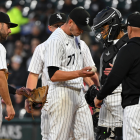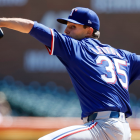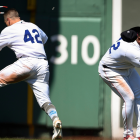From almost the moment the Nationals cut loose defrocked closer Jonathan Papelbon, rumors circulated that his old team in Boston would make a for a natural landing spot. The Red Sox are of course in contending mode, and help in the bullpen is likely needed.
On that latter point, the Sox this season rank just ninth in the AL in bullpen ERA (albeit a more respectable fourth in bullpen FIP). More specifically, Boston relievers this season have been significantly worse against right-handed batters than they have against right-handed hitters. They could use some help on that front, and that's the case even after the addition of Brad Ziegler via trade.
On another level, closer Craig Kimbrel hasn't been terribly consistent this season, and Papelbon, what with his 368 career saves, certainly has experience in that regard.
As well, Papelbon's, shall we say, "behavioral volatility," even seems to have a certain appeal for Boston. Here's this from Boston.com's Ryan Hathaway:
The news has drawn the ire of some, who point to the reliever's repeated instances of clubhouse clashes, but [GM Mike] Hazen counters that the team needs bullpen help and that it can be hard to add to a team once the trade deadline passes. He also added that sometimes that intensity can be channeled effectively, saying, "When the game starts to ratchet up in intensity, you know I agree, sometimes a little crazy can go a long way."
So we have Papelbon's availability, Boston's need, and Boston's acknowledgement that he's the subject of internal discussions. The real question, though, is whether the 35-year-old Papelbon can be effective moving forward.
This season, Papelbon has pitched to a 4.37 ERA in 35 innings -- not good, especially by the standards of high-leverage relievers. As well, that's backed up by a career-worst 2.21 K/BB ratio. Also of note is the strong downward trend on Papelbon's fastball velocity ...

As you can see, that's a steady state of decline. As recently as 2011, Papelbon averaged almost 96 miles per hour with his four-seamer. This season, it's down to 91.7 mph. Of course, it's been losing steam for some time, and Papelbon in, say, 2014 and part of 2015, thrived despite the lack of a vintage fastball. He did that by limiting hard contact off the bat and generally being stingy with walks.
On the first point, take a look at Papelbon's average exit velocity off the bat by location in 2015 (on the left) compared to 2016 (on the right) ...

As you can see, he's getting hit harder in almost every location this season (ignore those nil values on the right). In related matters, Papelbon this season is allowing soft-hit balls -- i.e., easy outs, usually -- at a rate of 10.3 percent, per FanGraphs. That's barely more than half his career mark of 19.3 percent.
Leaked velocity will of course make it easier for hitters to square up on a ball, and that's no doubt a factor with Papelbon. He's also throwing first-pitch strikes at a career-low rate, which has enabled hitter to lay off his offspeed stuff. All of that adds up to Papelbon's being ahead in the count just 33.9 percent of the time this season, which ranks near the bottom of the league among relievers who've thrown at least 500 pitches.
On another level, though, Papelbon's command-and-control indicators have been much stronger against right-handers, even in 2016. That's what you'd expect, of course, but the extent to which that's true has been even greater this season. The opposite side has been abusing his fastball for more than a full year now, so perhaps Papelbon needs to go to a more splitter-heavy approach against left-handed hitters.
Or, provided Papelbon is amenable to it, the Sox in this hypothetical reunion could tailor his role so that platoon-advantaged situations are maximized. That might just work, as Papelbon, even at his age and with a spiraling fastball, has still struck out 26.4 percent of the right-handed batters he's seen. So he's got that going for him, in addition to the crazy thing.
Need and current baseline make Papelbon a fit in Boston, but the Sox would need to carefully deploy him in order to minimize his current weaknesses. They can do that. As always, there's also the possibility of mechanical tweaks under a different coaching staff or short-run performance spike. Papelbon's a name, but his name is bigger than the role he should be given at this stage of things. It's up to Papelbon and the Red Sox as to whether that's doable on all sides.






















